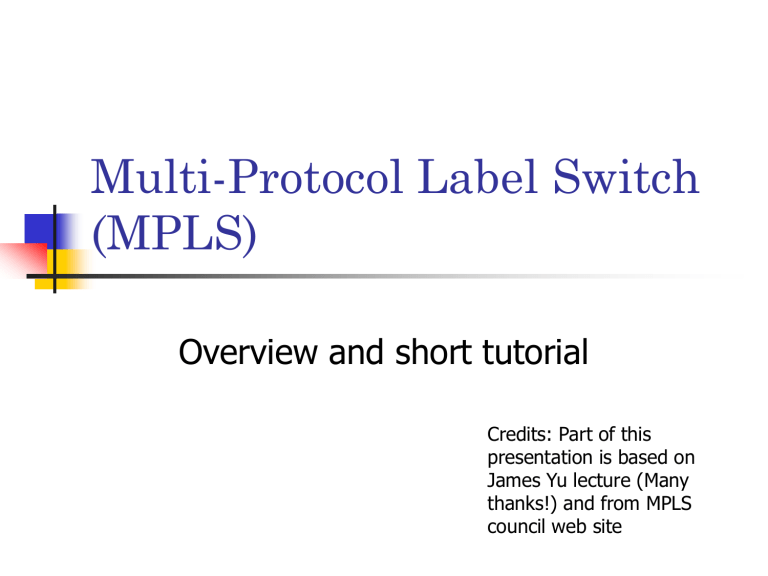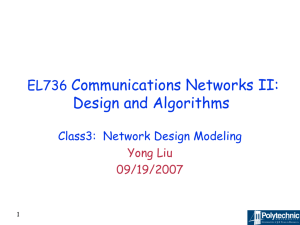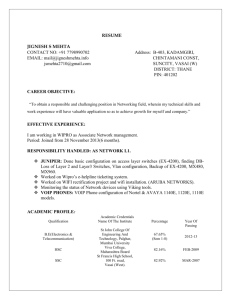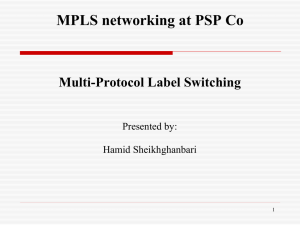Multi-Protocol Label Switch (MPLS)

Multi-Protocol Label Switch
(MPLS)
Overview and short tutorial
Credits: Part of this presentation is based on
James Yu lecture (Many thanks!) and from MPLS council web site
What is MPLS?
From MPLS Resource center:
“MPLS stands for "Multiprotocol Label Switching". In an MPLS network, incoming packets are assigned a "label" by a "label edge router (LER)". Packets are forwarded along a "label switch path (LSP)" where each "label switch router (LSR)" makes forwarding decisions based solely on the contents of the label. At each hop, the LSR strips off the existing label and applies a new label which tells the next hop how to forward the packet.
Label Switch Paths (LSPs) are established by network operators for a variety of purposes, such as to guarantee a certain level of performance, to route around network congestion, or to create IP tunnels for network-based virtual private networks. In many ways, LSPs are no different than circuit-switched paths in ATM or
Frame Relay networks, except that they are not dependent on a particular Layer 2 technology.
An LSP can be established that crosses multiple Layer 2 transports such as ATM, Frame
Relay or Ethernet. Thus, one of the true promises of MPLS is the ability to create endto-end circuits, with specific performance characteristics, across any type of transport medium, eliminating the need for overlay networks or Layer 2 only control mechanisms.”
What is MPLS?
OK now in plain English now please?
Packets enter MPLS Network at a “Label Edge
Router” (LER)
LER Affix a label to packet and forwards it to the
MPLS network
Label switches in the network at each hop makes forwarding decision solely based on label. That decision is made based on a pre-established
“Label Switch Path” (LSP).
Labels can be integrated with existing L2 info such as DLCI or ATM VCs.
Diagram in class.
MPLS Motivation
Original drivers towards label switching:
Designed to make routers faster
ATM switches were faster than routers
Fixed length label lookup faster than longest match used by IP routing
Allow a device to do the same job as a router with performance of ATM switch
Enabled IP + ATM integration
Mapping of IP to ATM had become very complex, hence simplify by replacing ATM signalling protocols with IP control protocols
MPLS Motivation
Growth and evolution of the Internet
The need to evolve routing algorithm
The need for advanced forwarding algorithm routing vs. forwarding (switching)
routing: flexibility forwarding: price/performance
Can we forward/switch IP packets?
Allow speed of L2 switching at L3
Router makes L3 forwarding decision based on a single field: similar to L2 forwarding Sppppppeeeeed
Some MPLS Benefits
Traffic Engineering - the ability to set the path traffic will take through the network, and the ability to set performance characteristics for a class of traffic
VPNs - using MPLS, service providers can create IP tunnels throughout their network, without the need for encryption or end-user applications
Layer 2 Transport - New standards being defined by the IETF's PWE3 and
PPVPN working groups allow service providers to carry Layer 2 services including
Ethernet, Frame Relay and ATM over an IP/MPLS core
Elimination of Multiple Layers - Typically most carrier networks employ an overlay model where SONET/SDH is deployed at Layer 1, ATM is used at Layer 2 and IP is used at Layer 3. Using MPLS, carriers can migrate many of the functions of the SONET/SDH and ATM control plane to Layer 3, thereby simplifying network management and network complexity. Eventually, carrier networks may be able to migrate away from SONET/SDH and ATM all-together, which means elimination of ATM's inherent "cell-tax" in carrying IP traffic.
MPLS History
IP over ATM
IP Switching by Ipsilon
Cell Switching Router (CSR) by Toshiba
Tag switching by Cisco
Aggregate Route-based IP Switching (IBM)
IETF – MPLS
http://www.ietf.org/html.charters/mpls-charter.html
RFC3031 – MPLS Architecture
RFC2702 – Requirements for TE over MPLS
RFC3036 – LDP Specification
MPLS and ISO model
(MPLS is a layer 2.5 protocol)
Applications
PPP
TCP
IP
FR
MPLS
ATM
Physical
UDP
Ethernet
MP
S
DWDM
When a layer is added, no modification is needed on the existing layers.
Label Switching
What is it?
Goal: sending a packet from A to B
We can do it in a broadcast way.
We can use source routing determines the path.
where the source
How do we do it on the Internet today?
Hop-by-hop routing: continue asking who is closer to B at every stop (hop).
Using Label on the network
(This is not new!)
ATM: VPI/VCI
Frame Relay: DLCI
X.25: LCI (logical Channel Identifier)
TDM: the time slot (Circuit Identification
Code)
Ethernet switching: ???
Q: do you see any commonality of these labels?
Label Substitution (swapping)
Label-A1
Label-A2
Label-A3
Label-A4
Label-B1
Label-B2
Label-B3
Label-B4
MPLS
A protocol to establish an end-to-end path from source to the destination
A hop-by-hop forwarding mechanism
Use labels to set up the path
Require a protocol to set up the labels along the path
It builds a network connection-oriented service on the IP
Terminology
LSR - Routers that support MPLS are called Label Switch Router
LER - LSR at the edge of the network is called Label Edge Router
(a.k.a Edge LSR)
Ingress LER is responsible for adding labels to unlabeled IP packets.
Egress LER is responsible for removing the labels.
Label Switch Path (LSP) – the path defined by the labels through
LSRs between two LERs.
Label Forwarding Information Base (LFIB) – a forwarding table
(mapping) between labels to outgoing interfaces.
Forward Equivalent Class (FEC) – All IP packets follow the same path on the MPLS network and receive the same treatment at each node.
How does it work?
Add label at the ingress LER
LER
LSR LSR remove label at the egress LER
LER
IP
IP
Routing
IP #L1 IP
Label
Switching
#L2
Label
Switching
IP #L3
IP
Routing
IP
MPLS Operation
Label Path: R1 => R2 => R3 => R4
Label Forwarding Information
Base (LFIB)
Router Incoming
Label
Incoming
Interface
R1 --E0
Destination
Network
(FEC)
172.16.1.0
Outgoing
Interface
Outgoing
Label
S1 6
172.16.1.0
R2
R3
6
11
S0
S0 172.16.1.0
S2
S3
11
7
R4 7 S1 172.26.1.0
Q: create LFIB for R4 => R3 => R2 => R1
E0 --
MPLS process
Label Switch Path
FEC
Routing Protocol
FEC
Label Swapping
LFIB
Classification
Label assignment
LFIB
Layer 2
Layer 1
Ingress
Node
Core
Node
FEC
Label removal
LFIB
Egress
Node
Label Encapsulation
Label information can be carried in a packet in a variety of ways:
A small, shim label header inserted between the Layer 2 and network layer headers.
As part of the Layer 2 header, if the Layer 2 header provides adequate semantics (such as ATM).
As part of the network layer header (future, such as IPv6).
In general, MPLS can be implemented over any media type, including point-to-point, Ethernet, Frame Relay, and ATM links. The label-forwarding component is independent of the network layer protocol.
Label Encapsulation
L2
Label
ATM FR Ethernet PPP
VPI/VCI DLCI Shim Label
L2
Header
Label IP
Header
Datagram
MPLS Encapsulation is specified over various media types. Labels may use existing format (e.g., VPI/VCI) or use a new shim label format.
Shim Header
The Label (Shim Header) is represented as a sequence of Label Stack Entry
Each Label Stack Entry is 4 bytes (32 bits)
20 Bits is reserved for the Label Identifier
(also named
Label)
Label
(20 bits)
Exp
(3 bits)
S
(1 bit)
TTL
(8bits)
Label : Label value (0 to 15 are reserved for special use)
Exp : Experimental Use
S : Bottom of Stack (set to 1 for the last entry in the label)
TTL : Time To Live
Forward Equivalent Class
(FEC) Classification
A packet can be mapped to a particular FEC based on the following criteria:
• destination IP address,
• source IP address,
• TCP/UDP port,
• class of service (CoS) or type of service (ToS),
• application used,
• …
• any combination of the previous criteria.
Ingress Label
6
FEC
138.120.6.0/24
Egress Label
9
Forwarding Equivalence Classes
(FEC)
LER LER
LSR
LSR
IP1
IP1 #L1
IP2 #L1
IP1 #L2
IP2 #L2
IP1 #L3
IP2 #L3
IP1
IP2 IP2
IP3 IP3 #L4 IP3 #L5 IP3 #L6 IP3
IP4 IP4 #L4 IP4 #L5 IP4 #L6
IP4
• FEC = A group of packets that are treated the same way by a router.
• The concept of FECs provides for flexibility, scalability, and traffic engineering.
• In legacy routing, the ToS field is used to determine FEC at each hop. In MPLS it is only done once at the network ingress.
MPLS Applications
Traffic Engineering
Virtual Private Network
Quality of Service (QoS)
Traffic Engineering
Traffic engineering allows a network administrator to make the path deterministic and bypass the normal routed hop-by-hop paths. An administrator may elect to explicitly define the path between stations to ensure QoS or have the traffic follow a specified path to reduce traffic loading across certain hops.
The network administrator can reduce congestion by forcing the frame to travel around the overloaded segments. Traffic engineering, then, enables an administrator to define a policy for forwarding frames rather than depending upon dynamic routing protocols.
Traffic engineering is similar to source-routing in that an explicit path is defined for the frame to travel. However, unlike source-routing, the hop-byhop definition is not carried with every frame. Rather, the hops are configured in the LSRs ahead of time along with the appropriate label values.
MPLS – Traffic Engineering
IP
Forward to
LSR 2
LSR 3
LSR 4
LSR X
Overload !!
LER 1
Overload !!
IP L
LSR 2
IP L
LER 4
IP L
LSR 3
End-to-End forwarding decision determined by ingress node.
Enables Traffic Engineering
IP
MPLS-based VPN
One of most popular MPLS applications is the implementation of VPN.
The basic concept is the same as ATM transparent LAN.
Using label (instead of IP address) to interconnect multiple sites over a carrier’s network. Each site has its own private IP address space.
Different VPNs may use the same IP address space.
Same as Frame Relay separation of different user traffic… but more” fashionable” to use word “VPN” today.
VPN_A
10.2.0.0
VPN_B
10.2.0.0
VPN_A
11.6.0.0
VPN_B
10.1.0.0
MPLS VPN Connection Model
MPLS
Edge
MPLS
Edge
MPLS Core VPN_A
11.5.0.0
VPN_A
10.1.0.0
VPN_B
10.3.0.0
VPN_A: 10.2.0.0/24, 11.6.0.0/24, 11.5.0.0/24
VPN_B: 10.2.0.0/24, 10.1.0.0/24, 10.3.0.0/24
MPLS VPN - Example
192.168.1.0
E1
192.168.2.0
E1
E2
192.168.3.0
LSP
-- E1 10 E3
-- E2 20 E3
70 E3 -- E1
80 E3 -- E1
E3
E1 E2
E3
10 E1 30 E2
20 E1 40 E2
50 E2 70 E1
60 E2 80 E1
E2
30 E3 -- E1
40 E3 -- E2
192.168.4.0
-- E1 50 E3
-- E2 60 E3
LSP
MPLS and QoS
An important proposed MPLS capability is quality of service (QoS) support.
QoS mechanisms:
Pre-configuration based on physical interface
Classification of incoming packets into different classes
Classification based on network characteristics (such as congestion, throughput, delay, and loss)
A label corresponding to the resultant class is applied to the packet.
Labeled packets are handled by LSRs in their path without needing to be reclassified.
MPLS enables simple logic to find the state that identifies how the packet should be scheduled.
The exact use of MPLS for QoS purposes depends a great deal on how QoS is deployed.
Support various QoS protocols, such as IntServ, DiffServ, and RSVP.
FEC QoS Classification
LSR
LER
MPLS label based on
1. physical interface
2. Source IP address
3. Destination IP address
4. Type of Service (ToS)
5. Protocol information
6. etc.
A priority scheme for different label switch path (LSP)
IP Differentiated Model
Layer 3
IPV4
Version
Length
ToS
1 Byte other IP header info Data
7 6 5 4 3 2 1 0
IP Precedence Unused
Bits;
0 1 2 3
0 1 2 3 4 5 6 7 8 9 0 1 2 3 4 5 6 7 8 9 0 1 2 3 4 5 6 7 8 9 0 1
+-+-+-+-+-+-+-+-+-+-+-+-+-+-+-+-+-+-+-+-+-+-+-+-+-+-+-+-+-+-+-+-+
| Label | EXP | S | TTL |
+-+-+-+-+-+-+-+-+-+-+-+-+-+-+-+-+-+-+-+-+-+-+-+-+-+-+-+-+-+-+-+-+
MPLS between Carriers?
Carrier-B
Carrier-A
Carrier-C Internet
Carrier-D
Q: Does LDP work on different carriers’ network?
A (short): not yet
A (long): no network-to-network interface (NNI) signaling
.. And I really don’t expect it in the near future…
Summary
MPLS is accepted by the industry to migrate ATM-based core to
IP/MPLS-based core.
It is applied to carrier networks and large enterprise networks.
How do we set the label path: LDP
What is the need: traffic classification
What are the applications: traffic engineering, VPN, QoS, etc.
Challenges:
NNI for MPLS
MPLS for the Internet







